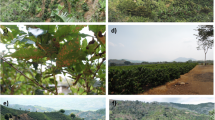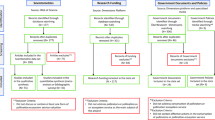Abstract
Ecosystem services are natural functions of an ecosystem that can be, secondarily, used for the benefit of humans. A recent estimate showed that ecosystem services equal, on average, 33 trillion dollars a year, with pollination being responsible for 112 billions dollars. The alteration of natural systems and the loss of pollinating species have caused a decrease in many crops' productivity. The objective of this work is to evaluate the pollination as an ecological service in agriculture, testing the hypothesis that the presence of forest remnants increases coffee agricultural productivity through an increase in pollination. This argument is based on the assumption that areas of preservation of native forest required by Brazilian law provide pollinators to local agroecosystems. Fruit production was compared among three different planting regimes: agrosilviculture, and conventional monoculture with and without preserved forest remnants nearby. The average flower production by branch was different among the farms and was not related to the planting methods. The first flowering was larger than the second, representing 81–98% of the flowers' total production. The farms near forest fragments had an increase of 14.6% in production that can be related to the pollinating services.
Similar content being viewed by others
References
Aizen M.A. and Feinsinger P. 1994. Forest fragmentation, pollination, and plant reproduction in a Chaco dry forest, Argentina. Ecology 75: 330–351.
Altieri M.A. 1999. The ecological role of biodiversity in agroecosystems. Agriculture, Ecosystems and the Environment. 74: 19–31.
Angermeier P.L. and Karr J.R. 1994. Biological integrity versus biological diversity as policy directives. BiosScience 44: 690–697.
Bezerra M.C.L. and Veiga J.L. 2000. Agricultura sustentável. Ministério do Meio Ambiente/Instituto Brasileiro do Meio Ambiente e dos Recursos Naturais Renováveis, Brasília, Brazil
Bhatia R., Gupta D., Chandel J.S. and Sharma N.K. 1995. Relative abundance of insect visitors on flowers of major subtropical fruits in Himachal Pradesh and their effect on fruit set. Indian Journal of Agricultural Sciences 65: 907–912.
Cardoso I.M., Gruijt I., Franco F.S., Carvalho A.F. and Ferreira Neto P.S. 2001. Continual learning for agroforestry system design: university, NGO and farmer partnership in Minas Gerais, Brazil. Agricultural Systems 69: 235–257.
Carvalho and Krug 1996. Coffee. In: Agriculture Research Service (ed) Agricultural Handbook. United States Department of Agriculture, Washington, DC, pp. 162–164.
Chichilnisky G. and Heal G. 1998. Economic returns from the biosphere. Nature 391: 629–630.
Collevatti R.G., Schoereder J.H. and Campos L.A.O. 2000. Foraging behavior of bee pollinators on the tropical weed Triumphetta semitriloba: Flight distance and directionality. Revista Brasileira de Biologia 60: 29–37.
Costanza R., d'Arge R., de Groot R., Farber S. and Grasso M. 1997. The value of the world's service and natural capital. Nature 387: 253–260.
Daily G.C. 1999. Developing a scientific basis for managing earth's life support systems. Conservation Ecology 3: 1–15.
Dix M.E., Akkuzu E., Klopfenstein J., Zhang J., Kim M.S. and Foster J.E. 1997. Riparian refugia in agroforestry systems. Journal of Forestry: 38–41.
Fearnside P.M. 1998. Serviços ambientais da floresta amazônica como estratégia para a sustentação da população rural na região. In: Watanabe S. (ed) Anais do IV Simpósio de Ecossistemas Brasileiros. ACIESP, São Paulo, Brazil, pp. 1–41.
Gobbi J.A. 2000. Is biodiversity-friendly coffee financially viable? An analysis of five different coffee production systems in western El Salvador. Ecological Economics 33: 267–281.
Graham R.T. and Jain T.B. 1998. Silviculture's role in managing boreal forests. Conservation Ecology 2: 8–19.
Hassell M.P. 1985. Insect natural enemies as regulating factors. Journal of Animal Ecology 54: 323–334.
Heard T.A. 1999. The role of stingless bees in crop pollination. Annual Review of Entomology 44: 183–206.
Hurlbert S.H. 1984. Pseudoreplication and the design of ecological field experiments. Ecological Monographs 54: 187–211.
Ish-Am G. and Eisikowitch D. 1998. Low attractiveness of avocado (Persea americana Mill.) flowers to honeybees (Apis mellifera L.) limits fruit set in Israel. Journal of Horticultural Science and Biotechnolgy 73: 195–204.
Karr J.R. 1981. Assessment of biotic integrity using fish communities. Fisheries 6: 21–27.
Kearns C.A., Inouye D.W. and Waser N.M. 1998. Endangered mutualisms: the conservation of plant-pollinator interactions. Annual Review of Ecology and Systematics 29: 83–112.
Keddy P.A. and Lee H.T. 1993. Choosing indicators of ecosystem integrity: wetlands as a model system. In: Woodley S., Kay J. and Francis G. (eds) Ecological Integrity and the Management of Ecosystems. St. Lucie Press, Ottawa, Canada, pp. 61–79.
Lys J.A. and Nentwig W. 1992. Augmentation of beneficial arthropods by strip-management. 4. Surface activity, movements and activity density of abundant carabid beetles in a cereal field. Oecologia (Berlin) 92: 373–382.
Machado P.A.L. 1989. Legislação das matas ciliares. In: Barbosa L.M. (ed) Simpósio sobre mata ciliar. Fundaçã Cargill, Campinas, SP, Brazil, pp. 2–10.
Malerbo-Souza D.T. and Nogueira-Couto R.H. 1997. Atrativo para as abelhas Apis mellifera e polinização em café (Coffea arabica L.). Mensagem Doce 44: 6–11.
Manzoorulhaq-Rafieuldin M. and Ghaffar A. 1978. Effect of insect pollination on fruit bearing in kinnow mandarin (Citrus reticulata), and physical and chemical properties of fruit. Journal of Apicultural Research 17: 47–49.
Masood E. and Garwin L. 1998. Costing the Earth: when ecology meets economics. Nature 395: 426–427.
Matheson A., Buchamann S., O'Toole C., Westrich P. and Williams I. (eds) 1996. The Conservation of Bees. Academic Press, London.
Moguel P. and Toledo V. 1999. Biodiversity conservation in traditional coffee systems of Mexico. Conservation Biology 13: 11–21.
Moreti A.C., Silva R.M.B., Silva E.C.A., Alves M.L.T.M.F. and Otsuk I.P. 1996. Aumento na produção de sementes de girassol (Helianthus annuus) pela ação de insetos polinizadores. Scientia Agricola 53: 2–3.
Naeem S. and Li S. 1997. Biodiversity enhances ecosystem reliability. Nature 390: 507–509.
Novaes W., Ribas O. and Novaes P.C. 2000. Agenda 21 Brasileira-Bases para discussão. MMA/PNUD, Brasília, Brazil.
Petrzelka P., Korsching P.F. and Malia J.E. 1996. Farmers' attitudes and behavior toward sustainable agriculture. Journal of Environmental Education 28: 38–44.
Pinto L.S., Pefecto I. and Hernandez J.C. 2000. Shade effect on coffee production at the northern Tzeltal zone of the state of Chiapas, Mexico. Agriculture, Ecosystems and the Environment 80: 61–69.
Ramalho M., Kleinert-Giovannini A. and Imperatriz-Fonseca V.L. 1990. Important bee plants for stingless bees (Melipona and Trigonini) and Africanized honeybees (Apis mellifera) in neotropical habitats: a review. Apidologie 21: 469–488.
Roubik D.W. 2002a. The value of bees to the coffee harvest. Nature 417: 708.
Roubik D.W. 2002b. Feral African Bees augment neotropical coffee yield. In: Pollinating Bees: The Conservation Link Between Agriculture and Nature. Ministry of Environment. Ministério do Meio Ambiente, Brasília, Brazil.
Ruark G.A. 1999. Agroforestry and sustainability: making a patchwork quilt. Journal of Forestry 97: 56.
Underwood A.J. 1997. Experiments in Ecology: Their Logical Design and Interpretation Using Analysis of Variance. Cambridge University Press, Cambridge, UK.
Vaissiere B., Rodet G., Cousin M., Botella L. and Grossa J. 1996. Pollination effectiveness of honey bee (Hymenoptera: Apidae) in a kiwifruit orchard. Horticultural Entomology 89: 453–461.
Veeresh G.K., Shaanker R.U. and Ganeshaiah K.N. (eds) 1993. Pollination in Tropics. International Union for the Study of Social Insects-Indian Chapter. Department of Entomology, University of Agricultural Sciences, Bangalore, India.
Vicens N. and Bosch J. 2000. Pollinating efficacy of Osmia cornuta and Apis mellifera (Hymenoptera: Megachilidae, Apidae) on red delicious apple. Environmental Entomology 29: 235–240.
Zar J.H. 1999. Biostatistical Analysis. Prentice-Hall, Englewood Cliffs, New Jersy.
Author information
Authors and Affiliations
Corresponding author
Rights and permissions
About this article
Cite this article
De Marco, P., Coelho, F.M. Services performed by the ecosystem: forest remnants influence agricultural cultures' pollination and production. Biodiversity and Conservation 13, 1245–1255 (2004). https://doi.org/10.1023/B:BIOC.0000019402.51193.e8
Issue Date:
DOI: https://doi.org/10.1023/B:BIOC.0000019402.51193.e8




